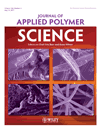Synthesis and characterization of nylon-6/mesoporous silica nanocomposites via in situ synchronous hydrolytic polymerization of tetraethylorthosilicate and ε-caprolactam
Abstract
Nylon 6 (N6)/mesoporous silica (MS) nanocomposites (NMSNs) were synthesized via in situ synchronous hydrolytic polymerization of tetraethylorthosilicate (TEOS) and ε-caprolactam. The novelty of this technique lies in that the nanosilica generated in situ has unique mesoporous structure and ultrahigh-specific surface area (SSA). Mechanical test showed that, compared to conventional precipitated silica (PS) nanofillers, the MS generated in situ shows better reinforcing efficiency on N6. At a loading of only 3.0 wt % MS, the tensile modulus, flexural modulus, and the heat distortion temperature of NMSNs exhibit increase of 54.8%, 77.9%, and 55.9°C, respectively. The effects of MS on the crystallization behaviors of N6 have been studied by differential scanning calorimetry (DSC), which shows that the incorporation of MS influences the crystallization behaviors of N6 obviously: (1) increases crystallization temperature (Tc) by serving as heterogonous nucleating agent; (2) favors the formation of γ-phase by hindering the mobility of N6 chains. Dynamic mechanical analysis confirmed that, compared ti that of neat N6, the temperature of the main α-relaxation (Tα) and the secondary β-relaxation (Tβ) of NMSNs is shifted 6.1°C and 5.3°C toward higher temperature. © 2010 Wiley Periodicals, Inc. J Appl Polym Sci, 2011




